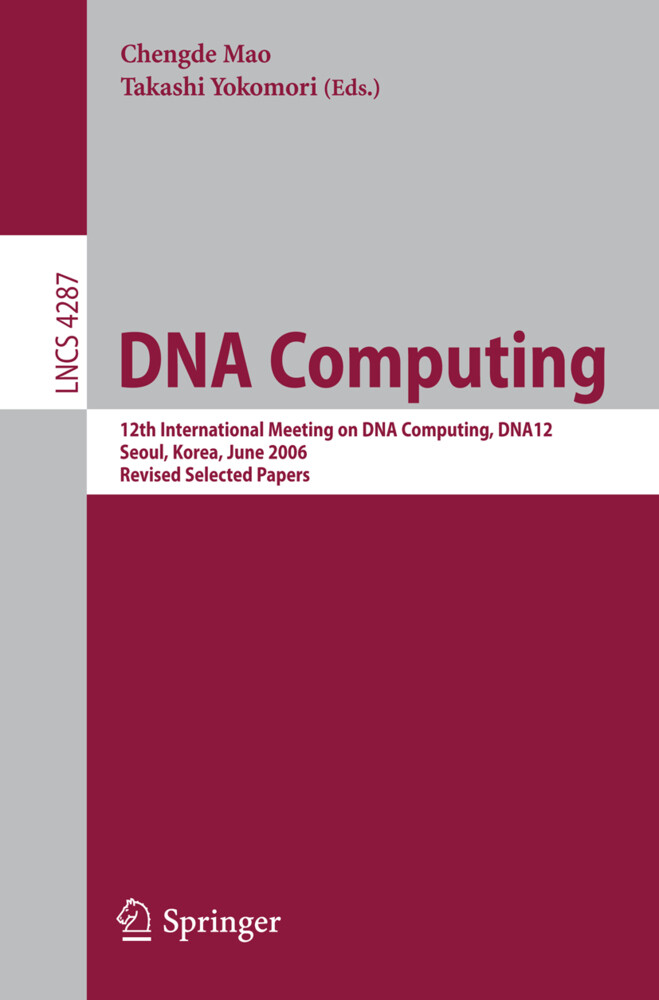
Zustellung: Di, 12.11. - Fr, 15.11.
Versand in 3 Tagen
VersandkostenfreiBestellen & in Filiale abholen:
This book constitutes the thoroughly refereed postproceedings of the 12th International Meeting on DNA Computing, DNA12, held in Seoul, Korea in June 2006. The 34 revised full papers presented are organized in topical sections on molecular and membrane computing models, complexity analysis, sequence and tile designs and their properties, DNA tile self-assembly models, simulator and software for DNA computing, DNA computing algorithms and new applications, novel experimental approaches, and experimental solutions.
Inhaltsverzeichnis
Molecular and Membrane Computing Models. - Computing with Spiking Neural P Systems: Traces and Small Universal Systems. - Minimal Parallelism for Polarizationless P Systems. - P Systems with Active Membranes Characterize PSPACE. - All NP-Problems Can Be Solved in Polynomial Time by Accepting Networks of Splicing Processors of Constant Size. - Length-Separating Test Tube Systems. - Gene Assembly Algorithms for Ciliates. - Complexity Analysis. - Spectrum of a Pot for DNA Complexes. - On the Complexity of Graph Self-assembly in Accretive Systems. - Viral Genome Compression. - Sequence and Tile Designs and Their Properties. - DNA Codes and Their Properties. - In Search of Optimal Codes for DNA Computing. - DNA Sequence Design by Dynamic Neighborhood Searches. - Sequence Design for Stable DNA Tiles. - Hairpin Structures Defined by DNA Trajectories. - DNA Tile Self-assembly Models. - Design and Simulation of Self-repairing DNA Lattices. - On Times to Compute Shapes in 2D Tile Self-assembly. - Capabilities and Limits of Compact Error Resilience Methods for Algorithmic Self-assembly in Two and Three Dimensions. - A Mathematical Approach to Cross-Linked Structures in Viral Capsids: Predicting the Architecture of Novel Containers for Drug Delivery. - Simulator and Software for DNA Computing. - A Framework for Modeling DNA Based Molecular Systems. - Uniquimer: A de Novo DNA Sequence Generation Computer Software for DNA Self-assembly. - A Probabilistic Model of the DNA Conformational Change. - Simulations of Microreactors: The Order of Things. - DNA Computing Algorithms and New Applications. - DNA Hypernetworks for Information Storage and Retrieval. - Abstraction Layers for Scalable Microfluidic Biocomputers. - Fuzzy Forecasting with DNA Computing. - Reasoning and Talking DNA: Can DNA UnderstandEnglish? . - Novel Experimental Approaches. - A New Readout Approach in DNA Computing Based on Real-Time PCR with TaqMan Probes. - Automating the DNA Computer: Solving n-Variable 3-SAT Problems. - Local Area Manipulation of DNA Molecules for Photonic DNA Memory. - Experimental Solutions. - Unravel Four Hairpins! . - Displacement Whiplash PCR: Optimized Architecture and Experimental Validation. - MethyLogic: Implementation of Boolean Logic Using DNA Methylation. - Development of DNA Relational Database and Data Manipulation Experiments. - Experimental Validation of the Statistical Thermodynamic Model for Prediction of the Behavior of Autonomous Molecular Computers Based on DNA Hairpin Formation.
Produktdetails
Erscheinungsdatum
14. Dezember 2006
Sprache
englisch
Auflage
2006
Seitenanzahl
456
Reihe
Theoretical Computer Science and General Issues
Herausgegeben von
Chengde Mao, Takashi Yokomori
Verlag/Hersteller
Produktart
kartoniert
Abbildungen
XII, 440 p.
Gewicht
686 g
Größe (L/B/H)
235/155/25 mm
Sonstiges
Paperback
ISBN
9783540490241
Entdecken Sie mehr
Bewertungen
0 Bewertungen
Es wurden noch keine Bewertungen abgegeben. Schreiben Sie die erste Bewertung zu "DNA Computing" und helfen Sie damit anderen bei der Kaufentscheidung.









